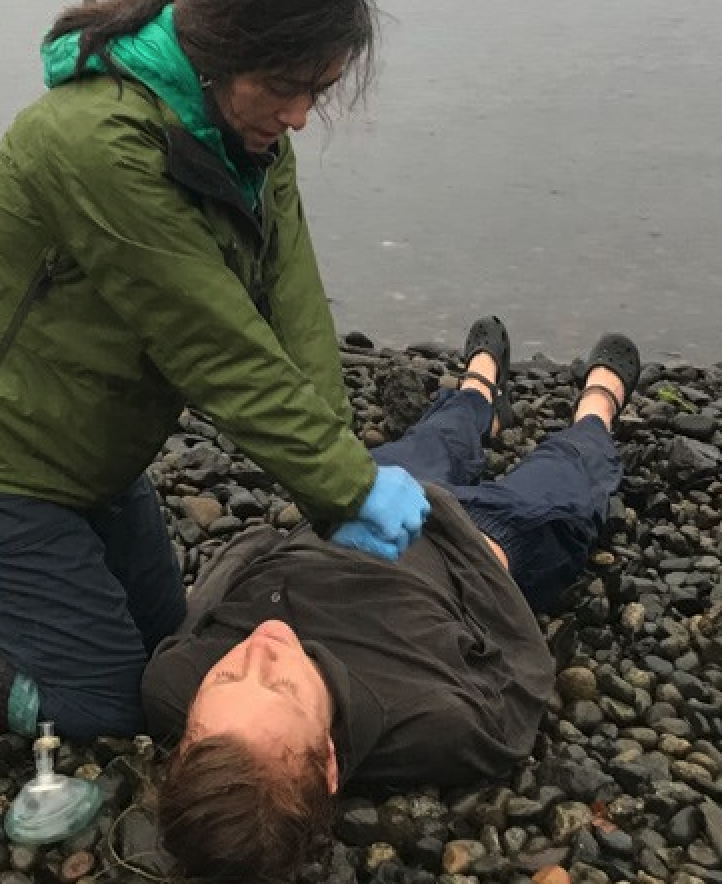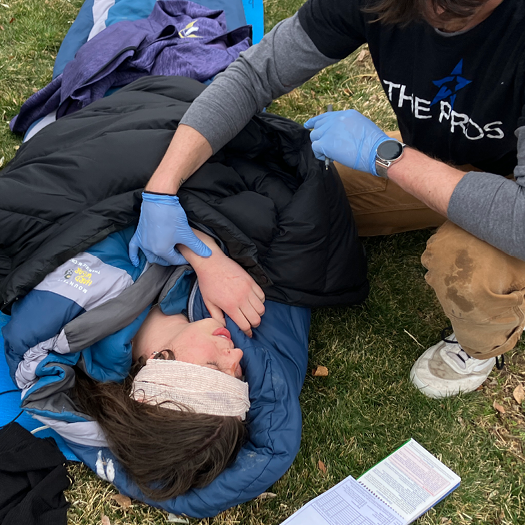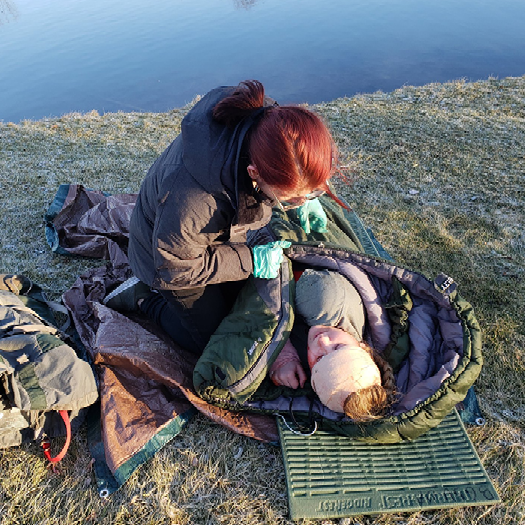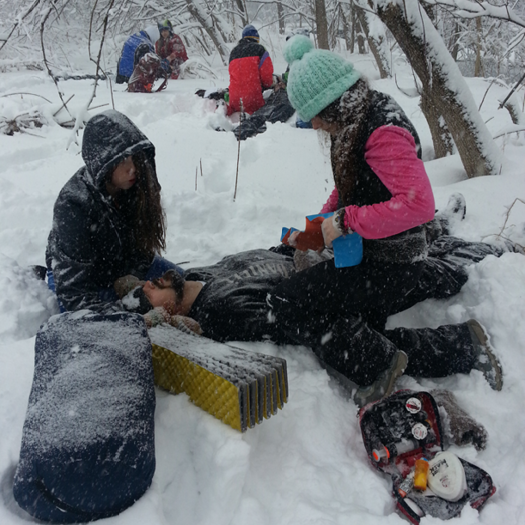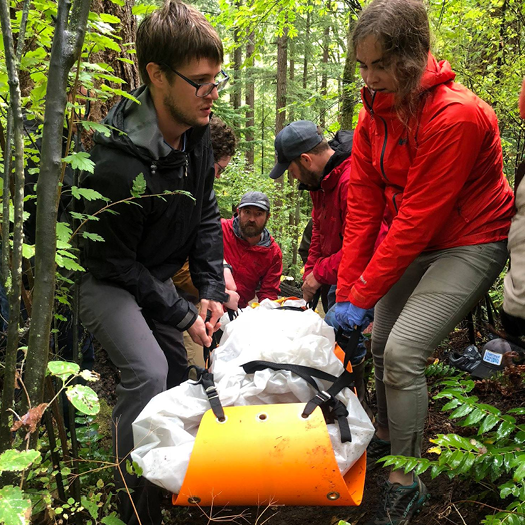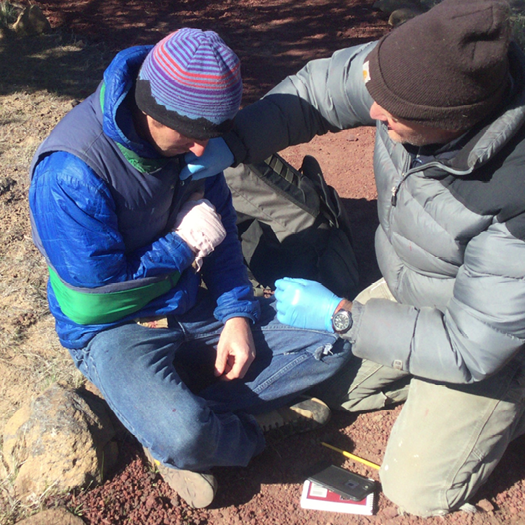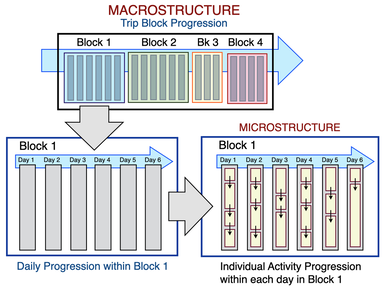Wilderness Basic Life Support (WBLS)
Our Wilderness Basic Life Support course is designed for people traveling with reliable cell phone coverage, outside assistance is typically available within one hour, and who are unwilling or cannot afford the money or time to take a longer course and are required to have first aid training ± CPR/AED certification for their job. The course focuses on basic life support — the assessment and treatment skills necessary to address a life-threatening injury or illness until more advanced help arrives — and meets Occupational and Safety Health Association (OSHA) standards. The course may also meet your state or organization's minimum CPR and First Aid requirements for coaches, camp staff, or guides [check with your state or organization]. Our Wilderness Basic Life Support goes a few steps further than urban BLS courses. It helps students understand when an urgent evacuation is needed, how to splint common extremity injuries, and how to safely assist ambulatory patients during an evacuation.
Most WBLS graduates return to take a longer, more intensive course. This course cannot be used to rercertify a WFA, WAFA, WFR, or WEMT certification. Wilderness Basic Life Support
± Adult & Child CPR & AED [depends on course] WBLS certifications are valid for a maximum of two years; to recertify, you must retake the original course before your certification expires. |
Wilderness First Aid (WFA)
Our Wilderness First Aid course is designed for people taking half or full-day trips, those traveling with reliable cell phone coverage, and where outside assistance is typically available within a few hours. WFA courses are an introduction to wilderness expedition medicine, focusing on general concepts and basic treatment skills. Many WFA graduates return to take a longer, more intensive course. The certification also meets American Camping Association and Scouts of America trip leader requirements. People with current WAFA, WFR, & WEMT certifications from approved providers can recertify via WFA and online testing. Learn more about recertification.
Wilderness First Aid
Injectable Epinephrine ± Adult & Child WCPR & AED [depends on course] WFA certifications are valid for a maximum of three years; to recertify, you must retake the original course before your certification expires. |
Wilderness Advanced First Aid (WAFA)
Our Wilderness Advanced First Aid course is designed for people taking half-, full, or short multi-day trips, those traveling with reliable cell or satellite coverage, and where outside assistance may be delayed for several hours. WAFA courses cover more topics and skills than our WFA course and dive slightly deeper into pathophysiology. People with current WAFA, WFR, & WEMT certifications from approved providers can recertify via WAFA and online testing. Learn more about recertification.
Wilderness Advanced First Aid
Injectable Epinephrine Adult & Child WCPR ± AED [depends on course] WAFA certifications are valid for a maximum of three years; there is no grace period; you must recertify before your certification expires. |
Wilderness First Responder (WFR)
Our Wilderness First Responder course is designed for outdoor professionals, those taking multi-day or extended trips, and people involved with high-risk activities (rock climbing, whitewater paddling, mountaineering, etc.). WFR courses provide the ideal training for people who travel in remote locations, in challenging weather, with limited equipment, unreliable communication, and little or no access to outside assistance. WFR certification is the industry standard for outdoor guides and instructors, and graduates are trained to care for patients for extended periods and to make independent decisions about evacuation and resources.
WMTC WFR graduates who receive certification as an EMT within one year of their WFR course may upgrade to a WEMT after passing our online WEMT exams. Wilderness First Responder
Injectable Epinephrine Adult & Child WCPR + AED WFR certifications are valid for a maximum of three years; there is no grace period; you must recertify before your certification expires. |
Wilderness Emergency Medical Technician (WEMT)
Our Wilderness EMT course is designed for experienced medical practitioners who are expedition medics or trip leaders. Participants must hold a current NREMT certification or state EMT license (basic, intermediate, or paramedic) with patient care experience to receive certification as a WEMT. Similar to our Wilderness First Responder course, our Wilderness EMT course focuses on assessing and treating traumatic, environmental, and medical emergencies in a wilderness environment. While the focus remains on expedition medicine, the treatment techniques apply to prolonged transport situations — disaster relief, SAR, rural EMS calls, etc.
EMTs can also receive WEMT certification by taking our standard WFR course and passing our online WEMT exams. WMTC WFR graduates who receive certification as an EMT within one year of their WFR course may upgrade to a WEMT after passing our online WEMT exams. Continuing Education Units
WMTC is not registered with CBEMS or any other CEU organization for EMTs, nurses, PAs, or physicians. Most training officers or education department supervisors affiliated with a licensed EMS service or hospital can approve CEUs. NREMT may grant (but is not obligated to) CEUs to EMTs who have taken a WEMT course based on topics, clock hours, and state approval (see preceding text). Nurses, PAs, and physicians can apply for CEUs through their hospital's education department. Those not affiliated with a hospital may be eligible for CEUs and should contact their state licensing or health department for guidance. Wilderness EMT
Injectable Epinephrine, Adult & Child WCPR + AED WEMT certifications are valid for a maximum of three years and expire with your NREMT or state EMT certification, whichever comes first. There is no grace period; you must recertify before your certification expires. |
WFR & WEMT Recertification (RECERT)
Our WFR & WEMT Recertification course focuses on updates, patient assessment, and evacuation while providing a thorough review of the original course material. 90% of the course is hands-on simulations, skill labs, and case study reviews. Please see the course syllabus or visit our Recertification Course page for details.
Graduates with current WFR or WEMT certifications — or those in their grace period — from an approved provider may recertify with us. We do not recertify graduates of online-only programs. Wilderness First Responder or Wilderness EMT
Injectable Epinephrine, Adult & Child WCPR + AED WFR certifications are valid for a maximum of three years. WEMT certifications expire with your NREMT or state EMT certification, whichever comes first. There is no grace period. |
Instructor Training Course (ITC)
This course is designed for outdoor and medical professionals interested in instructing WMTC medical courses. Potential candidates must apply for and complete our 18-day Instructor Training Course and apprenticeship. The ITC is demanding and will prepare graduates to enter the apprentice program, where they practice and fine-tune their instruction until they are ready to lead courses. Preparation for the ITC is challenging and requires ~80+ hours of work. Instructor candidates are preassigned specific lecture topics, skill sessions, and simulations to present during the ITC. The course culminates with the instructor candidates co-teaching a standard Wilderness First Aid course with their instructor trainer.
Successful Instructor candidates must:
Applicants must complete the WMTC Instructor Application. Please get in touch with the WMTC office with any questions.
Successful Instructor candidates must:
- Be a WMTC graduate with medical experience.
- Have professional trip-leading experience
- Have didactic and experiential teaching experience
- Mastered basic outdoor living and expedition skills
- Have advanced outdoor skills in at least one of the following areas: climbing, mountaineering, whitewater paddling or rafting, backcountry skiing, canyoneering, sea kayaking, or another equally technical outdoor activity.
Applicants must complete the WMTC Instructor Application. Please get in touch with the WMTC office with any questions.
Applied Anatomy & Physiology in Wilderness Medicine
This 75+ hour online course is designed for anyone who wants to learn how to care for themselves and those around them when professional medical assistance is unavailable. Potential students include:
- People who live remotely
- Preppers
- People who wish to be prepared for a natural disaster — flood, severe storm, earthquake, wildfire, etc. — when the 911 system and hospitals are overwhelmed.
- High school students looking for additional credits or an applied science course
- People interested in pursuing a career as a medic, nurse, PA, or physician
|
Tuition is $275 and includes a copy of our Wilderness Medicine Handbook, access to the course website, online tests, and digital patient notes.
|
This course does not include certification in wilderness medicine. If, after completing this course, you score a minimum of 80% on each of the final exams and are interested in becoming certified, please contact our office; you may be eligible to register for Part 2 of a hybrid WFA, WAFA, or WFR practical session. Compare course tuition & formats.
Effective Outdoor Program Design & Management
|
Outdoor trips do not exist in a vacuum; organizations design and operate them for a reason, typically expressed in a mission statement. Some are simple: clients learn how to paddle a canoe or kayak, climb a rock or mountain, live outdoors using indigenous technologies, etc. In addition to developing a specific outdoor skill or skills, organizations with more complex missions seek to foster positive relationships between trip members or with the environment. As a result, their mission statement may include character development, communication, or decision-making skills.
Regardless of their mission, the structure of all outdoor trips is the same. Each trip consists of multi-day blocks subdivided into individual day and activity blocks. Designers choose outcomes for each block that they hope will progressively lead students to a set of course outcomes defined by the program's mission. |
Click on an image to enlarge
|
Program directors are responsible for designing the trip macrostructure and hiring, training, and scheduling instructors. Field instructors manage the daily activity progression to ensure the block outcomes. The longer the trip, the more time instructors have to fine-tune the microstructure. Accidents and injuries occur when the competency/design balance is off and instructors lack the necessary site management skills to maintain the safety of an activity. A series of minor incidents precede each significant accident and injury, much like falling dominos precede the fall of the last domino. Program directors and instructors must have the ability to recognize seemingly minor incidents and intervene before the final domino falls and a severe injury occurs.
Our online course is modeled after our highly successful conference workshops and is designed for program directors, staff trainers, and senior instructors. The format is a progressive series of text, graphics, and video lectures that focus on identifying and understanding key design and management concepts, followed by exercises designed to give you practice using the material; students may submit their work for instructor feedback. Tuition includes three hours of one-on-one online discussion with a senior WMTC risk management instructor; you may break down the discussion time into hour or half-hour blocks and schedule them throughout the course. Additional consulting time is available for purchase. The course is currently under development and expected to launch in 2024.
Our online course is modeled after our highly successful conference workshops and is designed for program directors, staff trainers, and senior instructors. The format is a progressive series of text, graphics, and video lectures that focus on identifying and understanding key design and management concepts, followed by exercises designed to give you practice using the material; students may submit their work for instructor feedback. Tuition includes three hours of one-on-one online discussion with a senior WMTC risk management instructor; you may break down the discussion time into hour or half-hour blocks and schedule them throughout the course. Additional consulting time is available for purchase. The course is currently under development and expected to launch in 2024.
Course Tuition & Format Comparison
Course |
Tuition Range* |
Format |
Basic Wilderness First Aid (B-WFA) |
$95-$125 |
Standard only |
Wilderness First Aid (WFA) |
$250-$375 |
Standard & Hybrid |
Wilderness Advanced First Aid (WAFA) |
$450-$525 |
Standard & Hybrid |
Wilderness First Responder (WFR) |
$750-$950 |
Standard & Hybrid |
Wilderness EMT (WEMT) |
$750-$950 |
Hybrid only |
WFR & WEMT Recertification (Recert) |
$275-$375 |
Standard & Hybrid |
Applied Anatomy & Physiology in Wilderness Medicine |
$275 |
Online |
Effective Outdoor Program Design & Management |
TBA |
Online |
Instructor Training Course |
$1,400 |
Standard |
Certification courses in wilderness medicine are offered in either a standard or hybrid format. Briefly, standard courses are taught completely in person, while hybrid courses are taught online and in person. The in-person practical session for hybrid courses is shorter than a standard course as the lecture material is presented online. Learn more about the differences between standard and hybrid courses.
- Graduates of our Basic Wilderness First Aid course receive a completion card ± CPR/AED certification depending on the course; see the course syllabus for details.
- All WMTC certification courses exceed the certification standards published by the Wilderness Medicine Education Collaborative; see the course syllabus for details.
- All wilderness medicine students receive a copy of the Wilderness Medicine Handbook, our pocket-sized, waterproof, tear-resistant field guide, and patient notes — learn more about our pedagogy & delivery strategies.
- * See WMTC Columbia and WMTC Japan websites for local tuition
Hybrid course students have options for how they register and move through a course. In most cases, we recommend registering for both parts of a hybrid course at the same time by finding a course that works for you on our Courses page. Below are a few reasons why you might consider registering for the Part 1 online session now and separately registering for the Part 2 practical session later.
NOTE: You have 1 year to complete both parts of a hybrid course from the time that you register for Part 1. You can extend the year deadline for another year for a fee.
- You'd like to get started on Part 1 and there currently aren't any Part 2 practical sessions that work for you on our course schedule.
- You anticipate that Part 1 might take you longer than the typical time allotment and you'd like to get started as soon as possible.
- You have time now, but are unsure that you will have time closer to a practical session to complete Part 1.
- You're unsure about taking Part 2.
NOTE: You have 1 year to complete both parts of a hybrid course from the time that you register for Part 1. You can extend the year deadline for another year for a fee.

